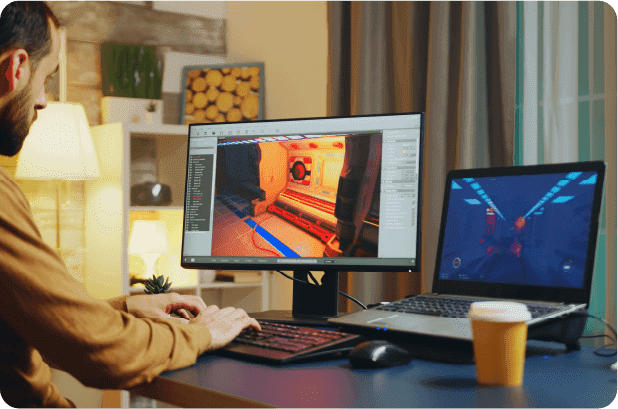
10 july 2022
Stages of Game Development: An Inside Look
Anyone with hands-on experience in the video game industry knows the simple fact: game
development can be chaotic. But while no amount of planning can fully safeguard you against
production bottlenecks or impending deadlines, undertaking a project without a plan is a sure
way to fail.
The game development process can be broken down into stages.
Pre-Production
Pre-production is the planning phase. You may have an amazing idea for a game, but to
successfully turn it into a reality you need a detailed plan of action.
Documentation is the
first step in creating a game it serves as the blueprint for developers while on production.
Pre-production is the stage when the writers, artists, designers, and developers
collaborate to determine the scope of the game. That includes coming up with ideas for how the
game will function, its characters, its look, and its story. Some details are likely to change
over the course of the game development process.
During pre-production stage, it is common
to prototype the environments, characters, controls and many other important in- game elements.
A lot of efforts also need to be invested into worldbuilding, storyboards, concept art,
interface and so on.
Production
Production stage is the place where the real game development takes place. Production stage is
when your studio takes the concepts created during the pre-production are turned into source
code and various assets. A bulk of time, resources and efforts goes into this stage. This also
happens to be the most challenging stages of video game development. During this process:
-
Character models are designed, rendered, and iterated on to look exactly how they should in
the story.
-
Audio design works tirelessly to ensure every time your character steps onto sand, gravel,
or cement, it sounds authentic.
-
Level designers craft environments that are dynamic, immersive, and suitable for many types
of playstyles.
-
Voice actors read large stacks of scripts, doing take after take to get the right emotion,
timing, and tone.
-
Developers write thousands-of-lines-of-source code to bring each piece of in-game content to
life
-
Project leads establish milestones and sprint schedules, ensuring each department and its
team members are held accountable. This is especially important if a publisher regularly
checks in for status updates.
Teamwork is key to success in this phase. Performing task in isolation from each other and lack of
communication results in a large number of errors and mismatch which again leads to constantly redo,
redraw something. Therefore, at Thirdeyeverse Technologies, we have built the most transparent
communication for working on the game to ensure instant feedback from any team member involved in
the project to sort of the possible obstruction in the path so that we can always accurately
estimate the required budget and time frame for the completion of work.
Testing
Quality assurance is often included in the production phase, but it is so important that it makes
sense to talk about it separately. Every feature and mechanics in the game needs to be tested for
quality control. Testing stands out from other phases of the game development as it keeps the game
from failure. Testers check the accessibility of all areas of the game, correct display of elements,
game controls and other features.
There are even different types of playtesters. Some playtesters conduct stress tests by running into
walls hundreds, if not thousands of times in an attempt to “break” the game. Other playtesters
conduct “fun factor” tests to see if the game is too hard or too easy, or complete the entire game
to see if it was satisfying enough. Without a “fun factor,” the game won’t sell many copies.
Launch
The most important step is left- the release of the game. Until this stage, the team can implement
some minor edits and additions. For games with many bugs, a studio will create a hierarchy of bugs
to squash. This hierarchy will include “game-crashing” bugs near the top and minor bugs near the
bottom.
Launching a game is providing it to game stores. Then players will be able to buy it or
download it for free, depending on which platform it is released for and on what terms.
Post-Production
The main work is over, the basic game design process and developments process are completed. What
lies ahead is the maintenance activity or post-production stage.
It’s not uncommon for video games to launch with batches of minor bugs. The first few months during
the post-launch stage are typically spent identifying and squashing these bugs. Gaming studios also
rely on players to submit bug reports or speak up about bugs in online forums. This is all part of
post-launch support.
Creation of patches and updates, such elements can be released at interval
of time such as seasons in most the multiplayer games with new assets and other downloadable content
to increase the user game interaction and user base. Thus making games in modern times is impossible
without this stage as this is essential to keep players engaged and bring them back into the game.
All this brings to conclusion that making video games is not easy and simple task it requires lot of
research efforts and resources to bring out the best engaging games to the users. That is exactly
what we at Thirdeyeverse Technologies brings to you.
We will make your game special. If you have an idea –
contact
us and we will put together your ideas
into the game you wished. Write to us if you have need any assist in game development we are always
ready to hear from you.
Tags:game development stages, Thirdeyeverse Studio, game design process, pre-production in gaming, game prototyping, production phase, game testing, post-production, game launch, game development cycle, game design principles, game development guide


